The contribution of EEA citizens to Scotland: response to the Migration Advisory Committee call for evidence - evidence annex
The Evidence Annex sets out the main elements of the most robust date we have on migrants and migration in Scotland.
Chapter 1 – Migration Trends
Key insights
- Scotland's projected population growth over the next 25 years is among the lowest across comparator European and UK countries.
- Since 2001, Scotland has been in a period of net in-migration driven by the growth in EU citizens coming to live and work in Scotland.
- All of Scotland's population growth over the next 10 years is projected to come from migration (58% of net in-migration is projected to come from overseas, with 42% from the rest of the UK) over the period 2016 to 2026, according to 2016-based national population projections.
- Scotland is projected to have the second largest decrease in its working age population (16-64 years) of all government office regions over the 10 years between 2014 and 2024 (according to 2014-based sub-national projections)
- Over a third of Scotland's local authorities face depopulation over the 25 years to 2039 (according to 2014-based sub-national projections).
- Scotland's population is ageing and the number of pensioners are projected to increase further by 25% over the next 25 years (according to 2016-based national population projections). The potential growing pressures on the economy can be offset by the young age cohorts of the EU migrant population.
- Lower levels of migration from the EU will result in slower population growth and will have a negative impact on the population sustainability of Scotland, and on the working age population in particular.
1.1 Trends in Scotland's population compared to the UK
Key insight: Scotland's population increasing mostly due to migration.
Scotland's population is at a record high of just over 5.4 million and has been growing in recent years mostly due to positive net migration. Natural change has not contributed significantly to the increase in Scotland's population, with deaths outweighing births over the past two years. This is in contrast to the UK as a whole where population increase is due to a combination of net in-migration and positive natural change (more births than deaths). Historically, Scotland has been a country of net out-migration. However, as can be seen in Figure 1.1, this has changed since 2000, with Scotland's recent population increase being driven by net in-migration.
Figure 1.1: Natural change and net migration, Scotland and UK, 1970-71 to 2015-16
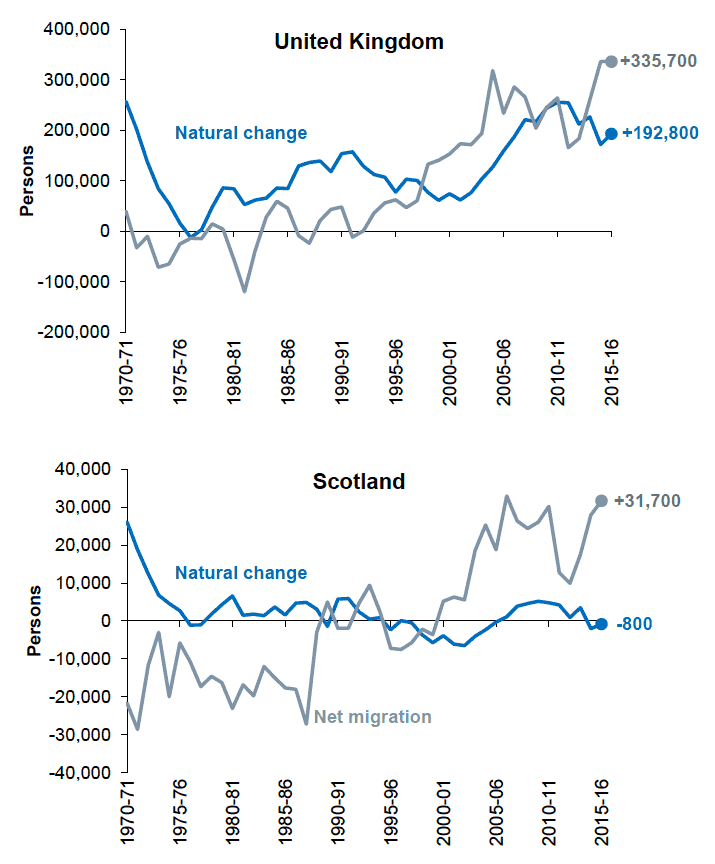
Source: Mid-Year Population Estimates, National Records of Scotland, Office for National Statistics
1.2 Migration trends
Key insight: Of international migrants moving to Scotland, EU citizens make
up a significant proportion of all in-migrants.
In 2015, 36% of in-migrants to Scotland were EU citizens, 12% Commonwealth citizens and 52% were citizens of other countries. The inward flow of EU citizens has generally fallen since the peak of 2007, but continues to make up around 40% of all inward migration each year. These estimates are based on the International Passenger Survey and measure the flow (or movement) of international migrants.
Figure 1.2: In-migrants to Scotland by citizenship, 2005-2015
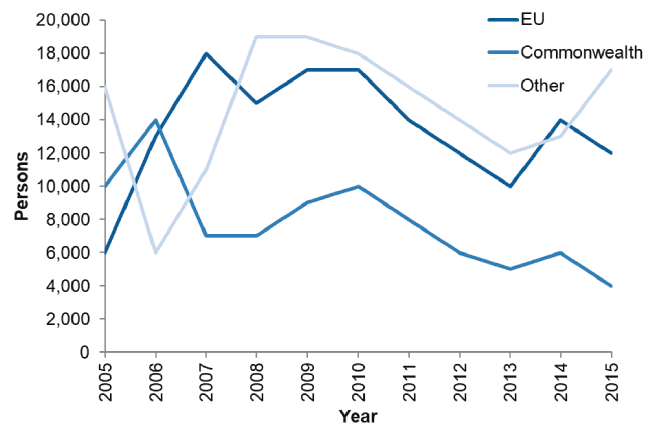
Source: International Passenger Survey, Office for National Statistics
Key insight: In 2016, there were 209,000 EU nationals living in Scotland.
Figure 1.3: Population by non- UK nationality, Scotland, 2016
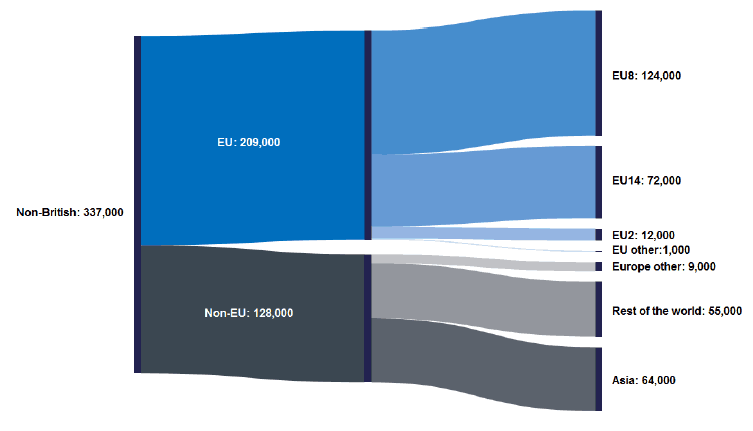
Source: Annual Population Survey, Office for National Statistics
Notes:
1. Nationality refers to that stated by the respondent during the interview. Where a respondent has dual nationality the first one is recorded.
2. Republic of Ireland nationals are included in the EU14 category.
APS analysis indicates that the number of EU nationals aged 16-64 years, residing in Scotland, increased by 57.6% from 105,000 in 2010 to 166,000 in 2016. The number of UK nationals aged 16-64 years decreased by 2.1% from 3,210,000 in 2010 to 3,142,000 in 2016.
In the period between 2010 and 2016, the number of EU14 nationals resident in Scotland increased from 57,000 to 72,000 in 2016. The number of EU8 nationals increased (by 74.4%) from 71,000 in 2010 to 124,000 in 2016 (see Figure 1.4).
Figure 1.4: Number and percentage of EU nationals living in Scotland by nationality group, 2007 to 2016
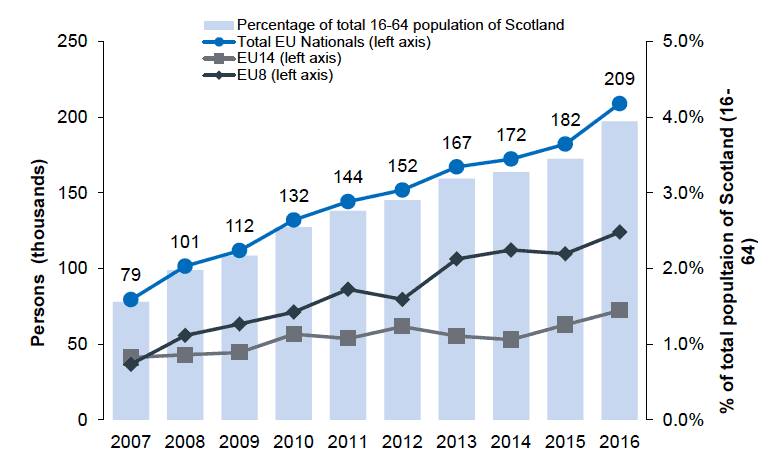
Source: Annual Population Survey, Office for National Statistics
1.3 Age of migrants
Key insight: The majority of migrants moving to Scotland are of prime working age.
Of the people moving to Scotland from overseas in the year to mid-2016, 84% were of working age (16-64 years). The peak age for migration into Scotland from overseas was 23, as illustrated in Figure 1.5. There were also high numbers of in-migrants (500 or more) for each age from 18 to 30, indicating that many migrants move for work or study reasons.
Figure 1.5: Migration to Scotland from overseas by single year of age, 2015-16
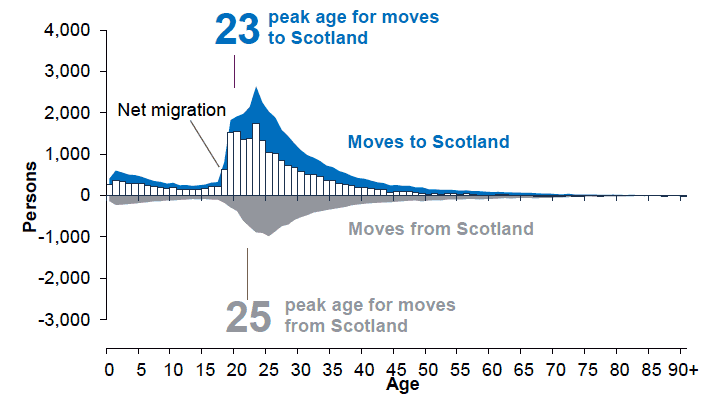
Source: Mid-Year Population Estimates, National Records of Scotland
EU nationals currently residing in Scotland have a younger age profile than non- EU nationals and the Scottish population as a whole. A larger proportion of EU nationals residing in Scotland were under 35 years of age (61.1%), compared with 54.3% of non- EU nationals and 41.5% for Scotland as a whole.
Over half (55.7%) of EU nationals were in the 25-49 age group and, therefore, of prime working age. There were 166,000 EU nationals aged 16-64 living in Scotland, 97,000 from the EU8 countries, those which acceded to the EU in 2004 (see Figure 1.6).
Figure 1.6: Proportion of EU nationals living in Scotland by age and nationality group [4] , 2016
![Figure 1.6: Proportion of EU nationals living in Scotland by age and nationality group[5], 2016 Figure 1.6: Proportion of EU nationals living in Scotland by age and nationality group[5], 2016](/binaries/content/gallery/publications/research-publication/2017/11/contribution-eea-citizens-scotland-scottish-governments-response-migration-advisory-committee/00527192.gif)
Source: Annual Population Survey, Office for National Statistics
1.4 Regional variations in components of population change
Key insight: Since the year to mid-2007, Scotland has relied on positive net migration for population growth more than any other constituent country of the UK.
Over that period, 88% of population growth in Scotland came from migration, with only 9% coming from natural change (more births than deaths). In contrast, for the UK as a whole, 53% of population growth came from net migration, with 45% from natural change. Northern Ireland relied on migration for population growth the least, with only 19% of growth being attributed to net inward migration (see Figure 1.7).
Figure 1.7: Components of population growth for the UK and constituent countries between mid-2006 and mid-2016
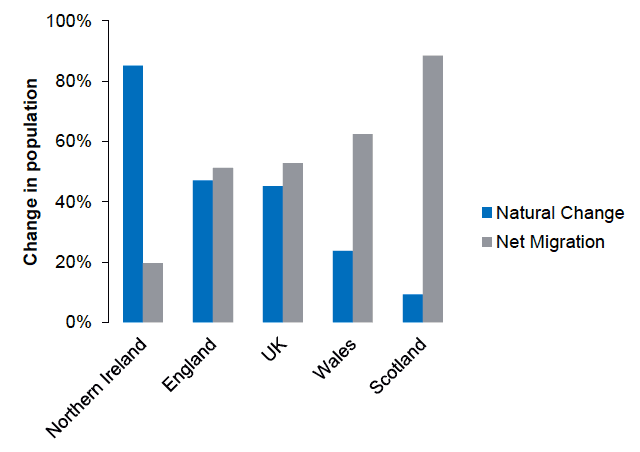
Source: Mid-Year Population Estimates, National Records of Scotland, Office for National Statistics
1.5 Migration flows across Scotland
Key Insight: All areas of Scotland benefit from migration.
Net inward migration to Scotland has meant that both urban and rural areas have benefitted from an inflow of working age migrants in recent years. As of mid-2016, 2.1% of the City of Edinburgh's population came from overseas between mid-2015 and mid-2016. This was the highest proportion in any council area in Scotland. Glasgow City and Aberdeen City council areas follow, with 1.9% and 1.8% respectively. Analysis of 2011 Census data indicates that migrants who have lived in Scotland for longer than ten years are approximately twice as likely to live in rural areas as are recent arrivals.
Figure 1.8: Inward migration as a percentage of population by council area, Scotland, mid-2015 and mid-2016
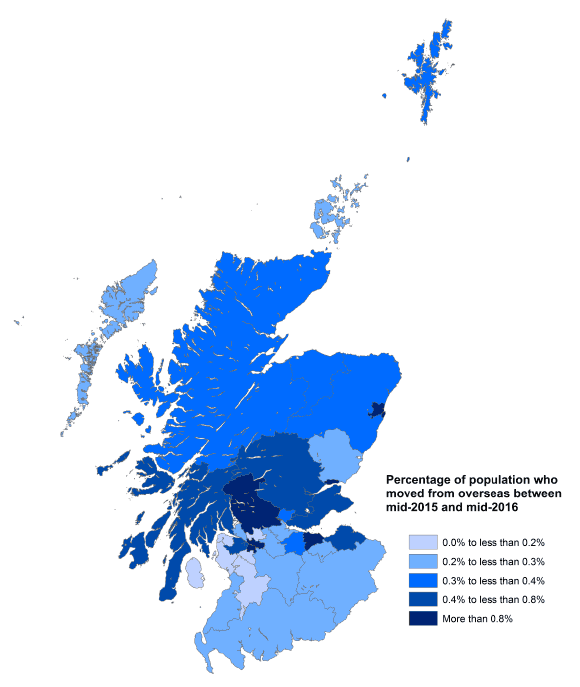
Source: Mid-Year Population Estimates, National Records of Scotland
Key insight: While Scotland's population is growing, this growth is uneven across our communities. Over a third (11 in total) of Scotland's local authorities will face depopulation before 2039.
This compares with only 3% (10 in total) of local authority districts in England. Continued inward migration can help support population growth and ensure the viability of Scotland's local communities. Local authorities facing depopulation are some of the most rural areas of Scotland, such as Na h-Eileanan Siar, Argyll and Bute and the Shetland Islands (see Figure 1.9).
| Scotland | England | |||
|---|---|---|---|---|
| number (%) local authorities | number (%) local authority districts | |||
| Areas with projected population increase | 21 | (66%) | 316 | (97%) |
| Areas with projected population decrease | 11 | (34%) | 10 | (3%) |
| Total | 32 | (100%) | 326 | (100%) |
Figure 1.9: Projected change in population, Scottish council areas, 2014-2039
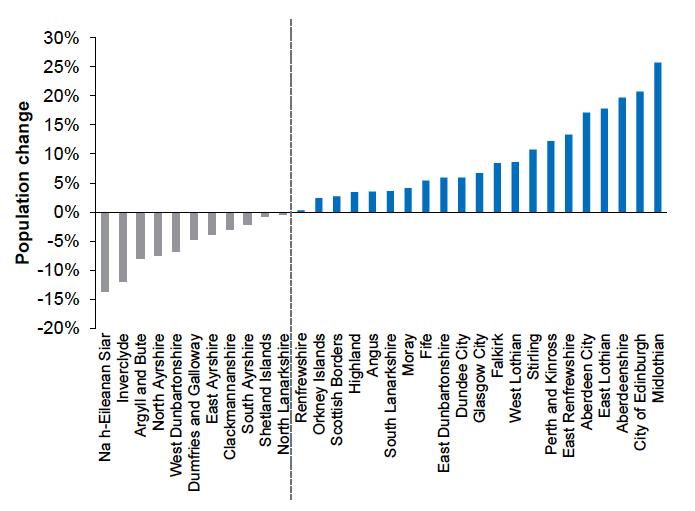
Source: Subnational Population Projections (2014-based), National Records of Scotland
Key insight: Scotland's geography illustrates how population density reflects the fragility of remote and rural communities.
For topographical and historical reasons, most of the population are contained within the lower-lying 'central belt', stretching from Ayrshire to Dundee (see Figure 1.8).
Remote and rural communities experiencing or at risk of depopulation need to attract and retain all their residents (including migrants) in order to maintain livelihoods and economies; migrants from outwith Scotland are therefore essential to addressing depopulation
1.6 Regional variations in the number of non- UK and EU nationals across the UK
Key insight: Scotland's non- UK national population make up a smaller proportion of the population than the UK average (see Figure 1.10) but Scotland has a higher than average proportion of the non-British population who are EU nationals (see Figure 1.11).
Scotland's population growth could be affected more by small changes to the inward flow of EU migrants.
Figure 1.10: Proportion of population who are non- UK nationals, UK and constituent countries, 2004 to 2016
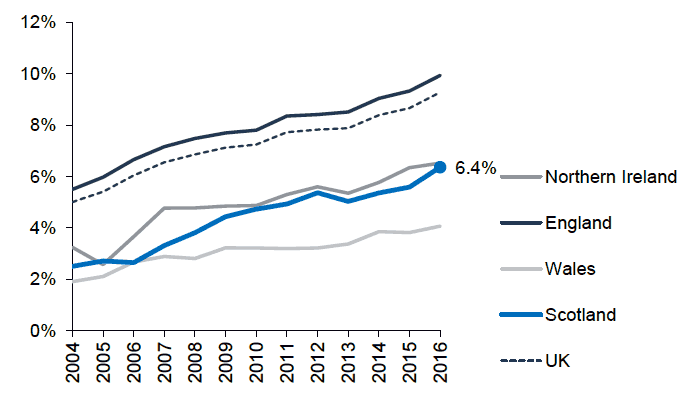
Source: Annual Population Survey, Office for National Statistics
Figure 1.11: Proportion of non- UK population who are EU nationals
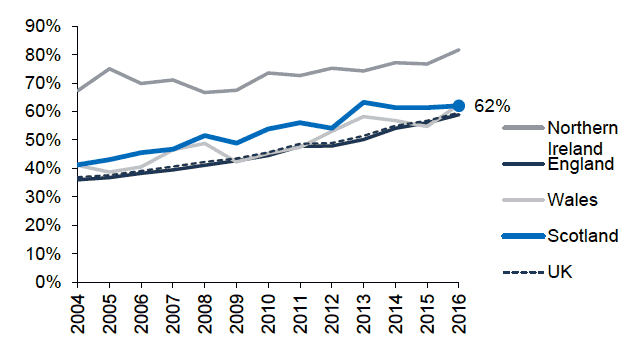
Source: Annual Population Survey, Office for National Statistics
1.7 Projected changes in Scotland's population
Key insight: Scotland's projected population growth over the next 25 years is among the lowest across comparator European and UK countries.
Scotland's population is projected to grow by 5% between 2016 and 2041, which is lower than most other European countries as well as the UK as a whole (see Figure 1.12).
Figure 1.12: Projected population change in selected European countries and UK countries, 2016-2041
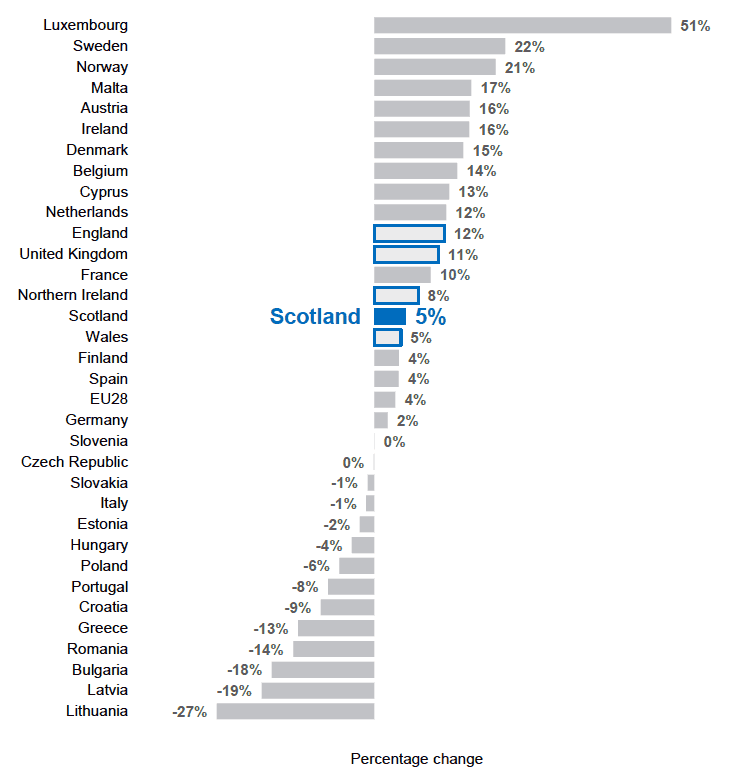
Source: National Population Projections (2016-based), National Records of Scotland
Key insight: Scotland's population is currently projected to increase by 5% between 2016 and 2041, lower than the projected increase in England (12%) and the UK as a whole (11%).
Figure 1.13: Projected population growth in the UK and constituent countries, 2016 to 2041
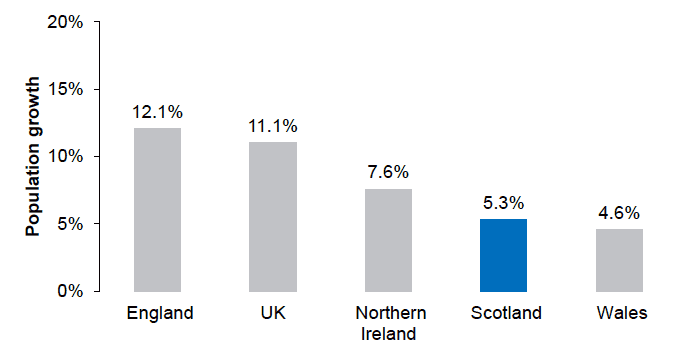
Source: National Population Projections (2016-based), National Records of Scotland
Key insight: Scotland's population is projected to grow slower than the UK as a whole.
The annual growth rate for the UK is projected to fall from 0.61% in 2017 to 0.30% in 2041. For Scotland, the annual growth rate will fall from 0.39% to 0.07% over the same period. As Figure 1.14 illustrates, this means that by 2041, the UK population will be growing at more than three times the rate of the Scottish population.
Figure 1.14: Projected annual population growth rates for Scotland and the UK, 2017 to 2041
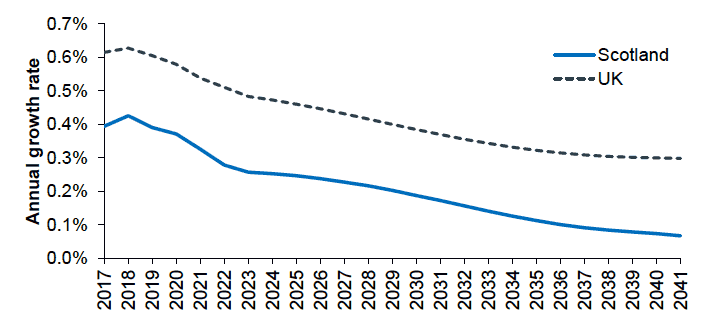
Source: National Population Projections (2016-based), National Records of Scotland
Key insight: All of Scotland's population growth over the next 10 years will come from migration (42% from the rest of the UK and 58% from international migration), according to 2016-based projections.
If current trends continue, the 2016-based population projections show that Scotland's population will continue to increase up to 2041. However the number of deaths are projected to consistently outweigh the number of births from 2027 onwards leading to negative natural change and slowing down the growth in Scotland's population. Whilst the UK is also projected to see a reduction in natural change, it remains positive with more births than deaths projected over the next 25 years (see Figure 1.15). This leads to a dependency in Scotland on migration for population growth.
As Figures 1.15 and 1.16 illustrates, this is in contrast to the UK. While 54% of the increase in the UK population is projected to come from international migration, a full 100% of Scotland's population growth is projected to come from migration (42% of which comes from the rest of the UK). If levels of net inward migration were to fall across the UK, Scotland's population growth could be affected more than that of the UK as a whole, due to much lower levels of natural increase in Scotland.
Figure 1.15: Natural change and net migration, Scotland and UK, 2001-02 to 2040-41
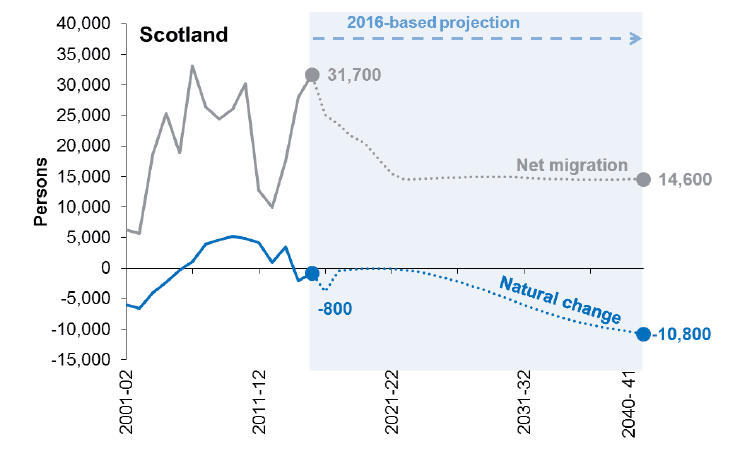
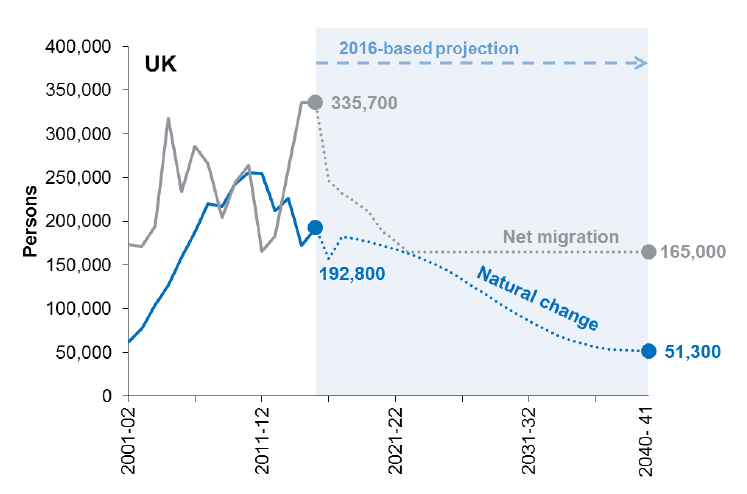
Source: Mid-year population estimates and National Population Projections (2016-based), National Records of Scotland, Office for National Statistics
Figure 1.16: Projected natural change and migration for Scotland and UK, 2016-2026
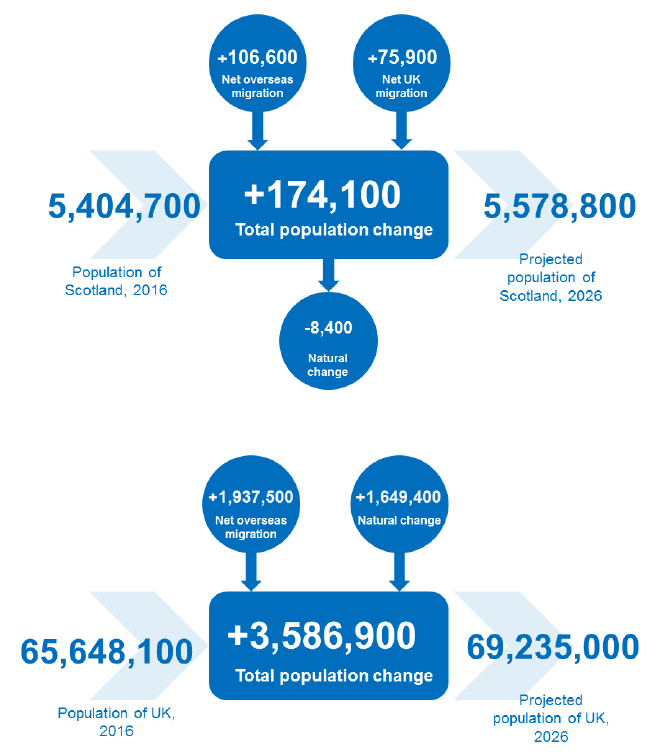
Source: National Population Projections (2016-based), National Records of Scotland
Key insight: Scotland is projected to have the second largest decrease (-1.5%) in the working age (16-64 years) population across all government office regions between 2014 and 2024.
Scotland's 0-15 years population will increase by the smallest amount (+2.2%) across all regions, and the population aged 65 and over is projected to increase by 20.1% (see Figure 1.17).
Figure 1.17: Projected population change by age group and government office region, 2014-2024
(Ranked by % change in population aged 16-64 years)

Source: National Population Projections (2014-based), National Records of Scotland Subnational Population Projections (2014-based), Office for National Statistics
Key insight: The number of dependants in Scotland is projected to increase over the next 25 years to 2041, due to the increasing number of people of pensionable age.
The increase in the dependency ratio is due to the increase in the number of people of pensionable age per 1,000 working age population. The dependency ratio for children is projected to decline slightly from 267 per 1,000 working age population in 2016 to 260 in 2041. For people of pensionable age, there is projected to be an increase in the dependency ratio from 307 pensioners per 1,000 working age population in 2016 to 380 in 2041. The effect of changes to the state pension age is seen through small dips in the number of dependents after both of the state pension age increases (see Figure 1.18).
Figure 1.18: Projected dependency ratios for Scotland, 2016-2041
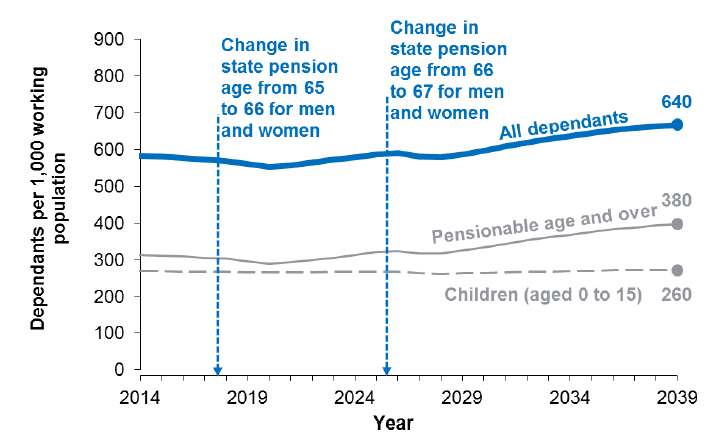
Source: National Population Projections (2016-based), National Records of Scotland
1.8 Impact of lower migration on Scotland's population growth
Key insight: Inward migration is key to sustaining Scotland's population growth.
Lower levels of migration from the EU will result in slower population growth for Scotland. This, coupled with the effect of an ageing population and low fertility rates, could change the demographic composition of Scotland. Latest 2016-based projections estimate Scotland's population will grow by 5% between 2016 and 2041. However, in a situation where EU migration to Scotland falls to half of current levels, population growth is 4% over the same period, and with no EU migration, population growth is 2%. These additional variants projections are trend-based and are not policy based forecasts, but they do provide helpful illustrations of the possible effect on Scotland's population of changes in EU in-migration (see Figure 1.19).
Figure 1.19: Change in population from 2016 to 2041, principal and alternative EU migration variant projections for Scotland and the UK
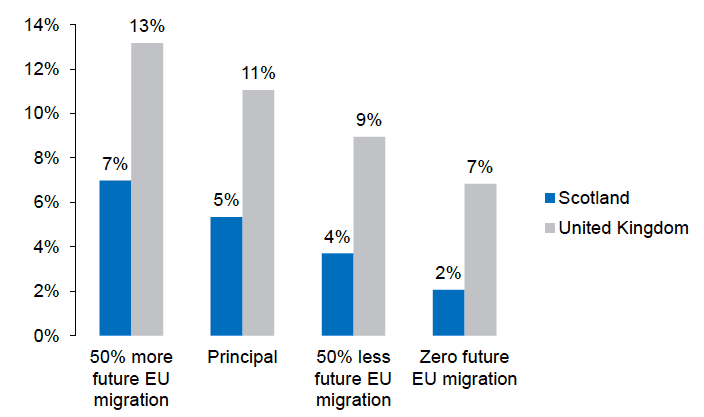
Source: National Population Projections (2016-based): Additional variants using alternative EU migration assumptions, National Records of Scotland
Key insight: If levels of EU migration decrease, the impact on the future age structure is of particular concern for Scotland.
Scotland's working age population is projected to grow by only 1% between 2016 and 2041, with the pension age population projected to increase by 25%. In a scenario of zero future EU migration, the pension age population will still grow by 25%, but the working age population will decrease by 3%. The scenario of zero future EU migration is used for illustrative purposes but helps to emphasise Scotland's need for continued inward migration from the EU in order to maintain the size of the working age population (see Figure 1.20).
Figure 1.20: Projected change in number of children, working age and pension age population, using current principal projection and zero future EU migration variants, 2016-2041
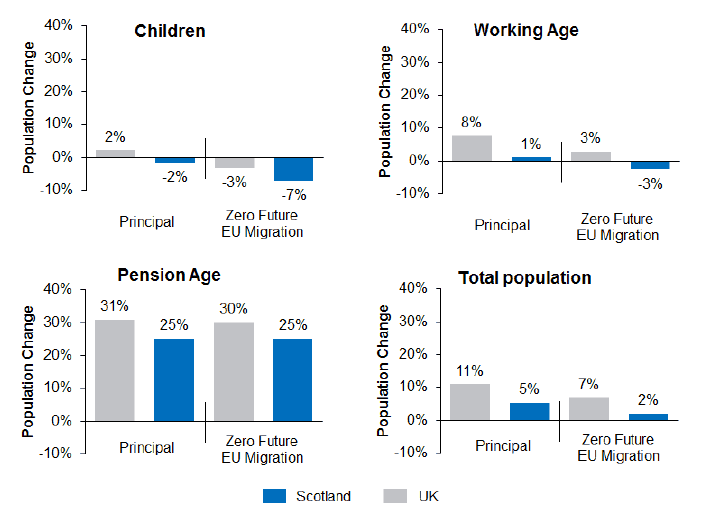
Source: National Population Projections (2016-based): Additional variants using alternative EU migration assumptions, National Records of Scotland
Contact
There is a problem
Thanks for your feedback